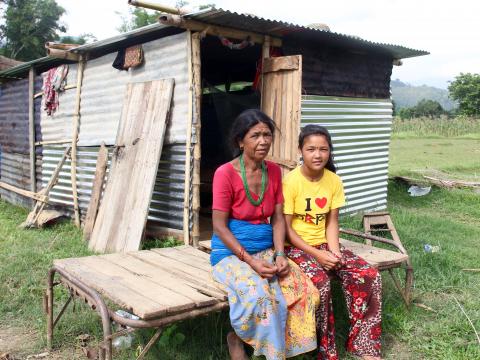Life has become uncertain for Gynendra

On April 25, 14-year Gynendra, a World Vision sponsored child, set off to feed her family's cattle since it was the weekend. Like what she normally does, she had to navigate to lower ground to find fields for the cows and drifted about an hour away from their home.
Suddenly, the ground started shaking and she heard a loud rumbling sound. Gynendra didn’t know that it was an earthquake until she saw collapsed houses in front of her.
“I thought about my Ama (mother),” Gynendra remembers. “She got sick before the earthquake happened.”
The moment she felt the shaking stop, she put down her doko (a wooden basket) and rushed home. While approaching her damaged house, she shouted out loud, “Ama, Ama!”
“I was scared. My Ama didn’t respond, I thought she was trapped somewhere,” says the young girl.
Thankfully, Gynendra found her mom standing in an open space with some neighbors, nearby her house.
“I also became worried for my daughter. I felt too weak that day. I’m thankful she’s safe,” says Gynendra’s mother, Sunita, 29.
Gynendra’s family went to sleep in a nearby field. Others were sleeping there, too -- afraid of being trapped indoors. Others had no homes left at all.
She learned that just a few minutes of the earth's violent rattling had forever changed their lives. The future, already filled with so many uncertainties for this struggling rural family, turned even more difficult after the quake.
After two big tremors hit Nepal last April 25 and May 12, more than 8,600 people were killed and 16,800 injured.
“I don’t know if we could build our house back. I miss my bed. I miss everything when my family stays home,” says Gynendra.
Gynendra still doesn’t sleep well at night. Although the house structure remains intact, it’s not safe to live there anymore.
“We heard a landslide below us. In the distance, we can see it clearly, triggered by the earthquake,” says Gynendra.
At Gynendra’s village, ninety percent of the homes were destroyed; those that survived were made of brick and concrete, as opposed to the more common stone and timber construction.
There's a din of clanking and hammering, as residents undertake the work of dismantling the wreckage themselves.
While humanitarian organizations like World Vision are working hard to reach the survivors who desperately need help, the rainy season is making things worse.
Heavy rain has intensified the hardships for the earthquake survivors who are sleeping out in the open because their homes were destroyed or they don't feel safe inside buildings amid continuing aftershocks.
The rain has also increased the risk of landslides and mudslides across rugged terrain already destabilized by the earthquake's tremors.
Thankfully, Gynendra’s family is one of the 13,000 families who received tarpaulins and tin sheets to put up temporary shelter. Her family also received water containers, solar lamps, blankets, jerry cans, sleeping mats, mosquito nets, hygiene kids, aqua tabs, and buckets.
“Relief operation is underway but there’s more work to be done. Given the situation, it will take much time to return life back to normal,” says Judy Moore, Manager, World Vision Nepal Earthquake Response.
To date, World Vision has assisted over 93,000 beneficiaries affected by the disaster with programs focused on distribution of non-food items (NFIs), shelter and water, sanitation and hygiene (WASH) materials, food/health and nutrition initiatives. Thirty-one child-friendly spaces were set-up and attended by over 4,000 children.
lthough things might be uncertain for Gynendra, she still hopes that better days will come soon.
“We lost a lot of things but what’s more important for me is being together with my family,” says Gynendra.